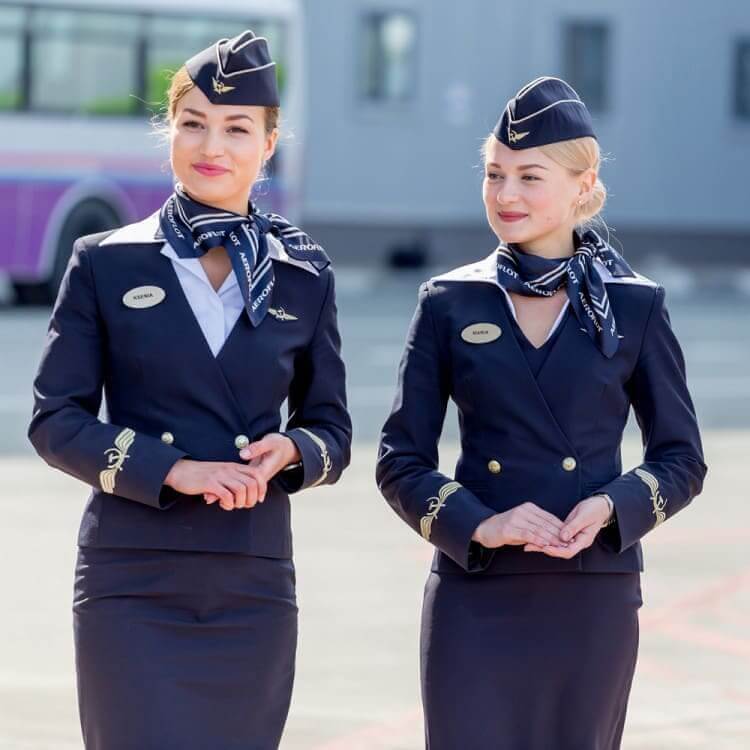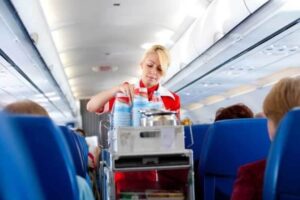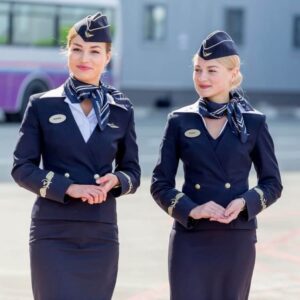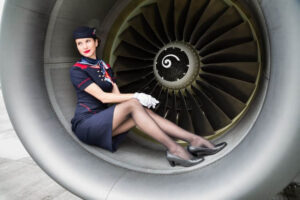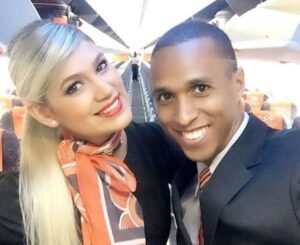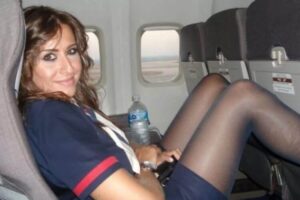his article was originally published on Travlerz
Whether you are an experienced traveler or not, there are many things about flying that you probably don’t know about. So, if you’re ever curious about how safe or clean planes are or the behind-the-scenes of what flight attendants actually go through, you’ll find everything you need to know in this article. Keep on reading to discover the ins and out of air travel.
Is Dating Passengers Allowed?
You may find it shocking but many big airlines don’t have an official policy against fraternizing between flight attendants and passengers. Unfortunately, it’s more common for flight attendants to find themselves in situations where they are actively trying to avoid unwanted attention from creepy passengers. But every once in a while, sparks fly and there is no policy that prevents a flight attendant from meeting a potential partner, or maybe the love of their life.
Flight attendants may focus more on their professional duties instead of finding potential partners on a flight, but when love strikes, why pass up the opportunity?
Turning Off Your Cell Phone Isn’t Actually That Necessary
Well, let’s clear up one thing, the airplane won’t suddenly go down if you leave your phone on or forget to put set it to airplane mode. Flight attendants simply urge passengers to turn off their electronic devices because they could potentially interfere with the frequencies that are used for air control. This is precisely why it is advised to especially turn it off during take-off and landing.
Even if your aunt is calling you to check if you are okay or you want to watch just one more Tik-Tok video, it can probably wait.
The Greeting Is More of An Assessment
When the flight crew greets you upon entering the aircraft, do you think it is just a polite formality? Well, most people think this practice is intended to make passengers feel comfortable and show how friendly the flight attendants are. It is true to some extent, but the crew members also use this as an opportunity to assess the passengers and look for anything suspicious or out of the ordinary.
The greeting is a way to get a better idea of passengers who could possibly be problematic or may be intoxicated.
Undercover Air Marshals
A sky or air marshall is someone who protects passengers and crewmembers from any criminal and terrorist attacks on board a civil aircraft. You may have watched the movie Non-Stop, in which a US air marshal receives threatening messages from someone demanding that his airline immediately transfer 150 million dollars to an offshore account. Just like Liam Neeson in this movie, air marshals must remain unnoticed and you really shouldn’t be able to recognize him or her on your flight.
You might think that there would be an air marshal on every flight however, they’re actually only on approximately 5% of flights.
Relationship Between Crew Members
Do relationships ever brew between the crew members? The simple answer is yes, it’s actually quite common. It may sound a bit stereotypical, but there are plenty of occasions where flight attendants and pilots have gotten together romantically. After all, the flight crew spends so much time together; long hours and multiple days in a row. It’s not surprising that they eventually find some comfort in each other.
A pilot and flight attendant romance would sure make a cute love story.
Think Twice Before Asking For Diet Coke
Of course one of the best parts of a flight is when the flight attendants come around with the snack and beverage cart, free soda, coffee, tea, maybe even cookies. As strange as it may sound, one thing that really annoys flight attendants is when passengers order Diet Coke. It’s because the carbonated fizz in a Diet Coke takes a long time to settle at an altitude of 35,000 feet. Therefore it takes the most time to pour Diet Coke as compared to any other beverages on the plane!
Of course, you will still be served Diet Coke regardless of the flight attendant’s preference, it’s just something interesting to remember the next time you ask for your soda on board.
The Job Doesn’t Pay Very Well
There is a common misconception that flight attendants live a very glamorous lifestyle. They are able to travel the world, explore different places, stay in hotels, and eat at restaurants all the time, all on the job! However, the truth is that they are almost always extremely busy and usually have very hectic schedules. Allegedly they are only paid once the main cabin doors shut too, meaning when there are delays and cancellations, they’re affected also!
Flight attendants are paid by scheduled flight times, so if a five-hour flight is delayed five hours, then they are only paid for the actual five hours on board!
How Safe Are Airplanes, Really?
The safety tactics explained at the beginning of every flight are proven to work! You know the safety tutorials about how to brace for a crash and use an oxygen mask? Most people like to sleep or listen to music while the flight attendants explain these procedures but they are crucial to keeping you safe. In fact, these tactics can actually save lives.
Have you ever wondered if the turbulence on a flight is dangerous? It’s very common and will not harm the plane, better to just buckle up and sit back until it ends.
What Do Crew Members Eat?
Did you know that those in the cockpit usually eat different meals? While there is no written rule by aviation authorities, airlines sometimes like to differentiate the meals between pilots and co-pilots. The reasoning behind this is, that if there happened to be a rare occurrence in which the pilots had food poisoning, it’s better to have one healthy pilot than two sick! The flight attendants are often offered the same food as the passengers but more often opt to bring their own food on board.
Airplane food is not exactly known to be gourmet so packing your own food on your next journey isn’t that bad of an idea.
Anyone Wants An Upgrade?
An upgrade is like winning a lottery in the air travel world. No one has a full-proof way of getting an upgrade every time but some flight attendants shared some insight into how they are chosen. Things that can usually strengthen your chances of getting a free upgrade are; being extremely tall, attractive, well-dressed, pregnant, or just a lucky friend of the flight crew. And hey, be nice to the flight crew, that always helps.
According to one anonymous flight attendant, getting an upgrade to first or business class is still possible even after the cabin doors close. Although it’s pretty rare who knows, you might just hit the jackpot someday.
Handling an Emergency On A Plane
Have you ever wondered what happens if there’s a medical emergency on a plane? Well, the flight attendants are given enough training to act as first responders! They can perform the Heimlich maneuver or administer CPR if needed. There are also first aid kits and any plane that carries over thirty passengers has defibrillators on board. Some aircrafts even have a facility called ‘MedLink’ where the flight crew can establish direct contact with a medical professional on the ground to gain advice.
Also, whenever there’s an emergency, the cabin crew asks if there’s a doctor on board. Research has shown that there are doctors onboard as many as 70% of all commercial flights, so the chances of someone being present are pretty high.
The Secret Code
Yes, all flight attendants can read each others minds. How else did you think they communicate? In all seriousness, the flight crew does have a secret communication code. They use this whenever there are certain things that they want to communicate with each other and don’t want others to understand. This is mostly done when they don’t want to cause any panic among the passengers, so they use certain codes to indicate what’s going on.
You may hear certain beeping noises during your flight and they are not just random call buttons. Apparently, the “dings” are used during takeoff and landing to signal to the crew that everything is okay, as the most dangerous stages of the flight are over. There are also other bells for things like severe turbulence, medical emergencies, and even if someone tries to enter the cockpit.
The Flight Crew Needs to Sleep As Well
Flight crews usually have hectic schedules and don’t always have the opportunity to take a nap. But of course, they’re human and they need to sleep just like the rest of us! On most domestic flights they don’t have the luxury of napping, but long-haul flights are a bit different. For instance, a Boeing 777 or 787 jet has a special sleeping cabin specifically for the flight crew.
Pilots also have assigned rest periods and designated sleeping spaces that are usually located in a separate area from the cockpit. When the pilot needs to get some much-needed sleep, the co-pilot takes over!
Not So Clean Water
Researchers advise airline passengers to never drink water aboard an airplane. But what about the potable water that’s used in tea and coffee? Many flight attendants also recommend sticking to bottled water or beverages only. This is because the coffee and tea on board are filled with water from tanks that aren’t cleaned frequently. Many major airlines even tested their water and found E. coli and coliform bacteria present.
It’s probably best to ask for a water bottle next time you’re thirsty during your flight!
There Are Certain Standards for How The Flight Attendants Need to Look
Some flight attendants shared that there are very rigid sets of criteria that they need to follow in terms of presenting themselves before each flight. And even beforehand, in the interview and hiring process! Things like age, weight, personal grooming, makeup, and outfit choices are all carefully considered. Although some airlines don’t make their flight staff follow these strict beauty standards anymore, they once dominated the industry.
Airlines do however continue to emphasize that flight attendants must have a professional appearance of course. They even have height parameters to ensure that the flight staff can easily perform all of their duties.
The Flight Attendants’ Lifestyle Misconception
Have you ever seen the movie View from the Top? If you have then you’d remember that the movie contains tons of scenes romanticizing the lifestyle that flight attendants live. They portray their lives as exciting, adventurous, and constantly thrilling. Painting a picture that when they work, it never actually feels like work but instead a day of fun. However, that’s not exactly the case, their job is quite demanding and very different from a 9-to-5.
Flight attendants and pilots usually have to spend a lot of time away from their loved ones. Their schedules consist of waking up early and even flying on weekends and holidays, so the job isn’t always easy.
They’re Not Stewardesses Anymore
Believe it or not, there were days when flight attendants used to only serve food and beverages to passengers on flights. But those days are long gone! Now, they do much more than wait on passengers, they must go through rigorous training and be prepared to handle various incidents regarding safety. Flight attendants are currently trained to administer CPR, AEDs, EpiPens, and defibrillators. It is definitely reassuring to know if any medical emergency happened on board, they would be prepared.
Flight attendants are also given courses in self-defense to handle unruly passengers. As well as being equipped with any knowledge necessary for an emergency evacuation or attempted hijacking of the plane.
Why Flight Attendants Turn Off The Cabin Lights During Takeoff and Landing
You may have always thought that the lights fade during your flight to create a more relaxing ambience for the passengers but apparently, that’s not the reason behind it. There is a much more serious purpose to dimming the cabin lights during commercial flights. Here is a hint for you: It has a lot to do with most airplanes experiencing accidents or problems mainly during take-offs and landings.
The main reason behind doing this is to allow your eyes to adjust to the lack of light in case there is an emergency. If there was a situation that required immediate evacuation, the exit and emergency signs are lit up and become more visible.
Unhealthy Airplane Food?
Sometimes ignorance is bliss, right? Well, you might’ve wondered if the pre-packaged food that is provided to passengers during their flights is healthy or not. The food tends to be processed and usually lacks fresh ingredients that wouldn’t be able to stay good during long travel. It turns out that these mid-flight meals are usually quite unhealthy for you because they have almost zero nutritional value. They are loaded with fat, sugar, salt, and carbs, and are not always the tastiest.
We would highly recommend you eat something before you board, especially if you are a frequent flyer or health-conscious.
The Brace Position Myth
Okay, let’s talk about the brace position myth. Do you know the one where you bend over in your seat, head between your legs, and hands on your neck? Well, the commercial aviation security procedures always recommend passengers adopt this specific position to brace themselves for impact, whether that be on water or land. Though many conspiracies have come about that insist this position actually leads to a quicker death. But good news, experts reject these conspiracies and say it is completely safe.
According to experts, the purpose of this brace position is to compact the body in a way that your vital organs are protected from any injury.
Extra Bags Don’t Make a Difference
A frequent frustration among those who fly consistently is that you’re only allowed to carry a certain number of bags with you on the plane. You also have to pay additional fees per bag which can become quite expensive. But this is all a safety precaution, right? The truth is that a few extra pounds won’t bring down the plane. In fact, most planes are designed in such a way that they can easily carry one extra bag per passenger!
The airplane industry does however need to maintain a weight balance on the plane to ensure there is the right center of gravity for takeoff. They do this by loading sandbags into the cargo of the plane to even out the weight distribution.
Getting Drunk on a Flight
Most people get excited seeing the mini bottles of alcohol on their flight, but sometimes drinking can get carried away, even on an airplane. If a flight attendant thinks that you’re getting a bit too buzzed, she can cut you off, no questions asked. It is because getting intoxicated on a plane is actually illegal! Flight attendants are forbidden from providing more alcohol to passengers who are already drunk. And if they are caught doing so, they can face big repercussions.
f you are intoxicated on a plane and cause a major disturbance, you can face criminal charges and a lengthy federal prison sentence. It’s also good to know that because of the changing cabin pressure, each glass of alcohol can affect you much more strongly than it would on land.
Important: Be Nice to Flight Attendants
It may go without saying but treat people with kindness. Being polite to people in your life is the best thing you can do, even if they are strangers. Especially if you are polite to your flight attendant, it can certainly go in your favor. Flight attendants work long shifts and frequently have to run from flight to flight without taking naps. A nice passenger can really make their day, and who knows maybe they’ll give you a free upgrade.
If you ever need to change your flight seating, it’s probably best to be extremely friendly and polite to your flight attendants. And if you are rude to them, who knows you might just get a seat in the middle of children or crying babies.
Ah, The Unused Food Question
If you ever wondered what happens to all of the unused food after every flight, it is probably best to not know the answer. Well, since you’re already here, we’ll tell you anyway. Some airlines simply dump all of the unused food which is extremely wasteful and unfortunate because it could definitely be donated to food banks or homeless shelters. But given that many airlines try to save as much money as they can, it would be no surprise if they served you some of the old food.
One travel catering expert claims that airplanes only serve fresh food which has been prepared between 12 to 72 hours ahead of time. Still, bringing your own food on board doesn’t sound like such a bad idea at this point.
About Those Blankets and Pillows…
There is no denying that the pillows, blankets, and headphones provided on airplanes are not thoroughly cleaned after each use. Even though they are repackaged with plastic wrap, airlines don’t spend money on providing new amenities to passengers every single flight. According to experts, the dirtiest part of a plane actually happens to be the tray tables. So, hopefully, this can bring you some relief knowing that what you’re using to sleep isn’t as bad as what you’re eating your food on.
On the other hand, you’re less likely to get fresh blankets and pillows in the coach class so it’s probably safest to just bring your own blanket and pillow.
Does The Pilot have The Ultimate Authority?
Pilots hold a lot of power and have the ultimate authority in an airplane. This includes leading the flight crew, making command decisions, and even handling passengers who may be causing trouble. There is an urban legend that if someone on an airplane is being problematic, there is nothing you can do! Well, pilots actually can make an arrest mid-flight, they can contact authorities and have someone arrested once the plane lands.
Pilots have to undergo large amounts of training to qualify for their position, after all, they have to communicate with air traffic control and monitor the plane with hundreds of lives on their hands!
Let’s Talk About Flight Safety
Regardless of how long the flight actually is, the most dangerous part is none other than the take-off and landing. This is because during this time the control is completely in the hands of the pilots so any little human error could cause a lot of problems! But don’t worry pilots need thousands of hours of practice before they can even qualify as a trained pilot.
According to statistics, flying a plane is much safer than driving. According to research done by the US government, the odds of being in an air crash are 1 in 7,178 in a lifetime and the odds of being in a fatal motor vehicle accident are 1 in 98.
What About Breathing the Plane Air?
Most would like to ignore the possibility of contracting an airborne virus while traveling in a plane. Nevertheless, questions about it still cross our minds. It’s hard to gauge how effective cabin ventilation systems actually are. How can they help if healthy people are traveling in a cramped cabin where someone is coughing and sneezing? Well, it is because you are breathing through the engine’s compressors. It’s known as the “bleed air” system which combines fresh and re-circulated air. In other words, it is similar to the air in an average office.
Flying with Pets
There has been a never-ending debate over the most effective way to travel on planes with pets. When it comes to traveling with your furry companions, it is undoubtedly a stressful ordeal. It is best to do your research beforehand and make sure your airline can accommodate your pup. There are special parts of the cargo area that are kept at the same temperature and pressure as the cabin, so pets can be placed there.
Does a Smaller Price Mean Less Safety?
If you have ever traveled on a budget airline, you may have wondered whether purchasing a ticket at a discount means you are also gambling on your safety. Thankfully you can relax because there is no need to worry about this sort of thing! Airlines would never compromise on the safety of passengers while determining ticket pricing, so your safety can be guaranteed just as it would be for a full-price ticket.
For plane tickets that are cheap, airlines usually customize other aspects such as seat selection, baggage fees, and legroom amenities to make more money.
Oxygen Masks Are Only Good For A Short Time
Frequent travelers may be familiar with the safety protocol explained by flight attendants at the beginning of every flight about oxygen masks. It is quite rare for you to find yourself in a situation using a drop-down oxygen mask in flight, but nevertheless, it is important to understand their purpose. During the time you are inhaling oxygen from the mask, the pilot is actually able to descend to an altitude where he is able to equalize the cabin pressure.
This tactic of using an oxygen mask can literally save your or someone else’s life.
Are Planes Really Clean?
Whether it is a surprise or not, most airplanes are not that clean. There are turnover crews that vacuum and empty trash from the cabin after each flight but what about the windows, armrests, and tray tables? Usually, these parts of the plane are heavily neglected and never thoroughly cleaned. This means these parts of the plane carry a ton of bacteria, the best thing you can do is to bring your own disinfectant wipes.
Moreover, the FAA, Federal Aviation Administration isn’t in charge of cleaning procedures, so the airlines often make their own decisions regarding cleaning, which results in not-so-clean planes.
What Really Goes On In The Baggage Compartment
Have you ever watched the luggage getting loaded into the airplane’s cargo and wondered “what’s up with those odd-shaped containers?” Well, they are not loading only passenger baggage! Many things can be transported in the underbelly of commercial planes. Those odd-shaped containers could even be human remains. If a person dies abroad then their remains need to be transported back to their home country, so it’s quite possible to have a human next to your suitcase!
A luggage handler is a very labor-intensive job, they need to carry and move over 100 suitcases and strategically fit them into a narrow compartment at the bottom of a plane, all day.
Don’t Get Too Cozy
The mere thought of traveling in a pressurized cabin with tons of strangers can give nightmares to some people and it is certainly not always a pleasurable experience. However, the airplane industry tries to make the journey as comfortable as it can for passengers. Inventions like neck pillows and eye masks have done wonders for us. But one thing about flying, unless you’re in first class, is it’s never comfortable enough.
You can get up to stretch your legs for a bit but it’s mostly a cramped space to be in. Some people like to take off their shoes and socks to feel more at home but we think that’s kind of gross so maybe not.
What If The Engine Fails in Flight?
Although it is quite rare to experience an engine failure in flight, there are some cases in which it has happened. Although if it did, you probably wouldn’t even notice it. Thankfully, present-day passenger jets are equipped enough to safely fly even if one of the engines fails. And even in the case that both engines fail, the plane can glide at approximately 1.5 nautical miles for every 1,000 feet of altitude.
So, there is no need to worry because pilots are specifically trained to handle this kind of situation.
The Reason Behind Expensive Flights
Passengers always find themselves groaning over the ever-inflating flight costs and we seriously don’t blame them for it. After all, it seems that airlines are constantly charging a ridiculous fee for almost everything. Did you know that the majority of profit an airline makes, is through baggage fees and seat fees? For an airline to even make a profit off of a ticket, an airplane has to fly at least 85% capacity.
Also, airlines often overbook flights because they need a certain amount of passengers to make a profit and this can ensure they hit that threshold in case people don’t show up for their flight.
The Best Time to Travel By Plane
As flight crews travel the most, they are the ones who know all about the best times to fly. The bad news is, you’ll have to wake up early. Although there is no guarantee, it is said that morning flights have less turbulence and therefore fewer cancellations or rescheduled flights. There is also usually less hassle at the airport. Your plane is even less likely to run into thunderstorms or weather issues.
The basic rule about choosing the best day of the week to fly is Tuesday or Wednesday. Since there are fewer people who would like to fly mid-week it usually ends up being the cheapest and the least busy.
Using Autopilot
If you’ve ever wondered how often the autopilot feature is actually used during flights, you’d be surprised to know that pilots activate autopilot for almost 90% of commercial flights! However this is no cause for concern so don’t freak out, pilots are still very present. And they have full control of the most important and critical moments of the flight: the takeoff, landing, and taxing to the gate.
The autopilot is only used for the cruising periods of the flight and simply allows the pilot to focus on other tasks such as communication operation and navigation.
Where to Sit On A Plane – Safety Wise
If we look at the statistics from studies of aircraft crashes, we’d find that the seats in the rear of the plane have the highest rates of survival. This data is so specific that it even shows us, that those in the rear third row of the plane have the best chance of survival as compared to the front or middle rows. Your chances also increase if you are sitting on the aisle seat or near an exit.
Despite your seat choice, your chances of survival severely drop if you don’t fasten your seat belt. Though this is all very scary information, the US government suggests that the majority of airplane accidents are indeed survivable.


